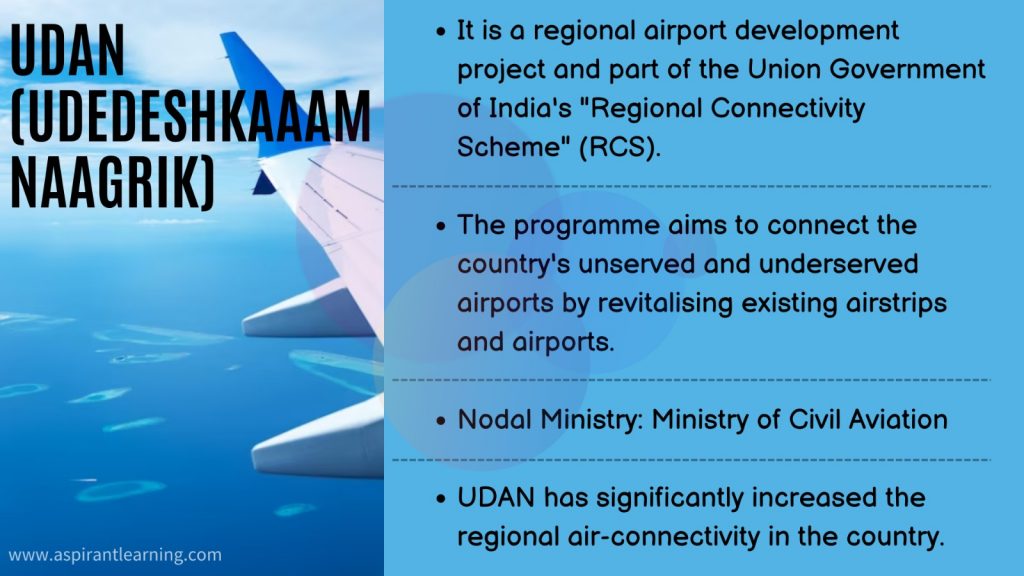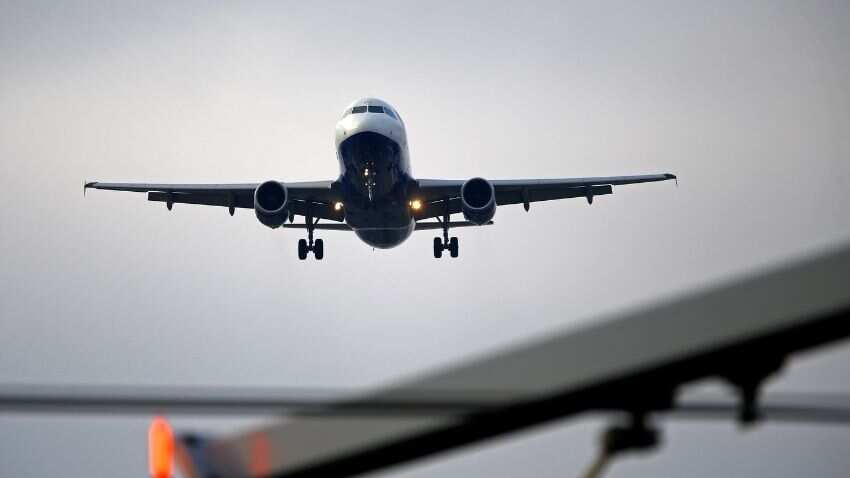News Highlight
Civil Aviation Ministry launches UDAN 5.0 to enhance connectivity to remote areas further.
Key Takeaway
- The government has begun the fifth phase of the Regional Connection Scheme — UDAN — to connect the country’s rural and regional communities.
- With this, the Ministry of Civil Aviation (MoCA) began requesting airline bids on April 21.
- It has released a bid document for various routes under this fifth round of bidding for its regional connectivity initiative UDAN.
- According to a tweet from the Ministry of Civil Aviation on April 21, only Category 2 and Category 3 aircraft operations are permitted.
- It will be included in this round with no distance restrictions between the origin and destination, and the stage length cap of 600 km will be lifted.
UDAN 5.0
- About
- The Ministry of Civil Aviation launched the initiative to promote regional airport development and regional connectivity.
- It is part of the 2016 National Civil Aviation Policy.
- The programme is valid for a duration of ten years.
- Objectives
- Improve aviation connection to India’s distant and regional areas.
- Remote area development, increased trade and commerce and tourism expansion.
- Make economic air travel available to the whole public.
- Job creation in the aviation industry.
- Key Features
- Under the scheme, airlines must set airfares for 50% of total seats at Rs. 2,500 per hour of flight time.
- This would be achieved through;
- A financial boost in the form of concessions from the federal and state governments and airport operators.
- VGF (Visibility Gap Funding) – A government payment given to airlines to bridge the gap between operating costs and predicted income.
- The Regional Connectivity Fund (RCF) was established to address the scheme’s viability gap financial requirements.
- The partner state governments would contribute 20% to this fund.
Previous Phases of the Scheme
- Phase 1 began in 2017 to connect the country’s underserved and unserved airports.
- Phase 2 began in 2018 to increase air connectivity to more rural and inaccessible areas of the country.
- Phase 3 began in November 2018 to improve air connectivity to the country’s hilly and inaccessible regions.
- Phase 4 of the UDAN scheme was launched in December 2019, focusing on connecting islands and other remote areas of the country.
Achievements under the UDAN Scheme
- The plan has also been able to give a reasonable level of air connectivity to Tier-2 and Tier-3 cities at low costs, altering how people travel.
- The number of operational airports has increased from 74 in 2014 to 141 today.
- Under the UDAN initiative, 68 underserved/unserved destinations have been connected, including 58 airports, 8 heliports, and 2 water aerodromes.
- With the launch of 425 new routes, UDAN has offered air connectivity to more than 29 states and territories nationwide.
- More than one crore travellers have benefited from this scheme.
Challenges Associated with UDAN Scheme
- Pandemic
- Due to low demand, most 300 routes have been impacted.
- Market-driven scheme
- The failure of UDAN is significant because it is a market-driven plan.
- It falls to the government to make the routes far more profitable for airline businesses.
- High operating costs
- The civil aviation ministry also admitted to a parliamentary committee of the aviation industry.
- Given the low yields and high running expenses, it is a challenging ecology to be a part of.
- Delayed upgradation of infrastructure
- The poor development of UDAN implementation is due to delayed infrastructure and airport preparedness upgrades.
- As well as a lack of proper right of way at some RCS airports.
- It also causes delays in obtaining appropriate regulatory permissions.
- Lower demand
- Inconsistent operations are caused by low demand on the few routes given.
- As well as severe and unpredictable weather conditions.
- In a few situations, this has resulted in the closure of operations by some airlines.

Way Forward
- Viable regional aviation ecosystem
- Creating a competitive and successful regional aviation environment is crucial for Indian aviation’s orderly evolution.
- Need to develop airports
- Most importantly, airports in these areas must be developed to make them operationally viable for 70-80 passenger aircraft.
- Accessibility
- The government should also guarantee these airports are accessible from neighbouring catchment areas.
- Taxes on fuel need to be reduced
- It has been a demand in the industry for a long time.
Pic Courtesy: Zee Business
Content Source: The Hindu



